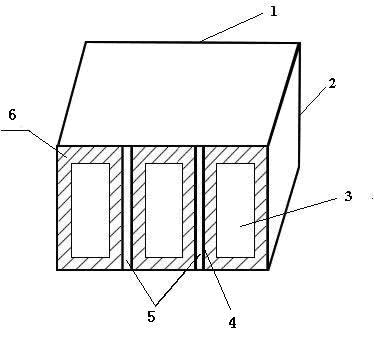Composite phase change material for heat dissipation of lithium battery and device
A composite phase change material and heat dissipation device technology, which is applied in the field of lithium-ion battery temperature control, can solve the problems of poor temperature consistency and low heat dissipation efficiency, and achieve the effects of good consistency, high heat dissipation rate, and convenient operation and maintenance
- Summary
- Abstract
- Description
- Claims
- Application Information
AI Technical Summary
Problems solved by technology
Method used
Image
Examples
Embodiment 1
[0030] Tetradecane (molecular formula: C 24 h 50 ) and expanded graphite composite phase change material, its phase transition temperature is 50°C, where C 24 h 50 The mass fraction is 90%, and the phase change material is solid at room temperature. Select 15 3.2V20Ah single batteries, and use the series connection method to form the battery pack module, such as image 3 As shown; when the battery module is discharged at high power, the temperature of the battery cell rises rapidly, and its heat is transferred to the composite phase change material through the battery casing. When the temperature is higher than 50 ° C, the composite phase change material absorbs heat and generates solid-liquid Phase change, but the composite phase change material still maintains solid properties and stores heat, so as to realize the heat dissipation and cooling of the battery cell and control the temperature rise of the battery cell; when the ambient temperature is 25°C and the discharge ti...
Embodiment 2
[0032] Using lauric acid (molecular formula: CH 3 (CH 2 ) 10 COOH) and expanded graphite composite phase change material, its phase transition temperature is 43 ° C, where CH 3 (CH 2 ) 10 The mass fraction of COOH is 87%, and the phase change material is solid at room temperature. Select 15 3.2V20Ah single batteries, and adopt the method of series connection to form a battery pack module; when the battery module is discharged at high power, the temperature of the battery monomer rises rapidly, and its heat is transferred to the composite phase change material through the battery shell. At 43°C, the composite phase change material absorbs heat and undergoes a solid-liquid phase transition, but the composite phase change material still maintains solid properties and stores heat, thereby realizing heat dissipation and cooling of the battery cell and controlling the temperature rise of the battery cell ; When the ambient temperature is 25°C and the discharge time is 20s, the ...
Embodiment 3
[0034] Using palmitic acid (molecular formula: CH 3 (CH 2 ) 14 COOH) and aluminum foam composite phase change material, its phase transition temperature is 64 ° C, where CH 3 (CH 2 ) 14 The mass fraction of COOH is 60%, and the phase change material is solid at room temperature. Select 15 pieces of 3.2V20Ah single batteries, and adopt the method of series connection to form the battery pack module; when the battery module is discharged at high power, the temperature of the battery monomer rises rapidly, and its heat is transferred to the composite phase change material through the battery shell, when the temperature is high At 64°C, the composite phase change material absorbs heat and undergoes a solid-liquid phase transition, but the composite phase change material still maintains solid properties and stores heat, thereby realizing heat dissipation and cooling of the battery cell and controlling the temperature rise of the battery cell ; When the ambient temperature is 2...
PUM
 Login to View More
Login to View More Abstract
Description
Claims
Application Information
 Login to View More
Login to View More - R&D
- Intellectual Property
- Life Sciences
- Materials
- Tech Scout
- Unparalleled Data Quality
- Higher Quality Content
- 60% Fewer Hallucinations
Browse by: Latest US Patents, China's latest patents, Technical Efficacy Thesaurus, Application Domain, Technology Topic, Popular Technical Reports.
© 2025 PatSnap. All rights reserved.Legal|Privacy policy|Modern Slavery Act Transparency Statement|Sitemap|About US| Contact US: help@patsnap.com



